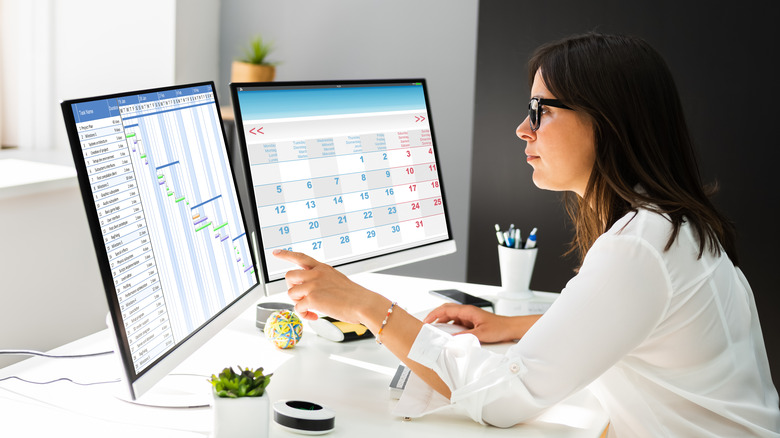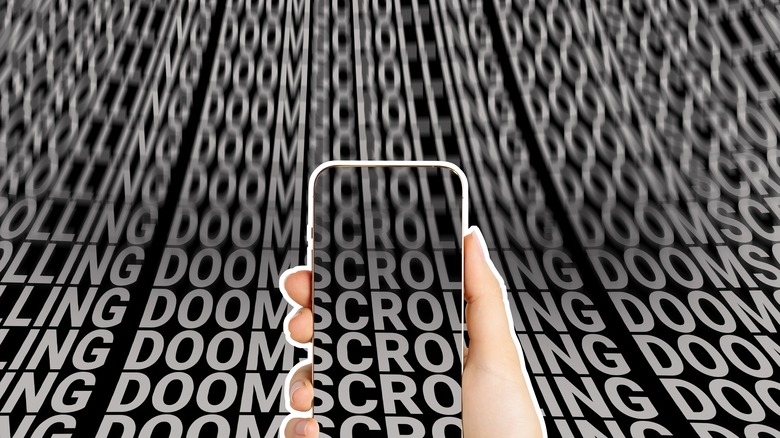Signs Your Screen Time Could Be Making You Sick
Every day, the average American spends 22 hours indoors (via USA Today). These days many people feel stuck inside; they're avoiding COVID-19 exposure, isolating because they're sick, tired from stress, dodging poor air quality due to wildfire smoke, you name it. The pandemic has pushed countless people to rely on their phones and laptops for both business and pleasure — lunch dates turned into zoom meetings, classrooms moved online, and working from home is the new normal. And when you're bored from all that time spent indoors, it's easy to turn to your phone for entertainment.
As a result, screen time is at an all time high. Worldwide, people spend an average of nearly seven hours looking at screens every day. Gen Z kids clock about nine hours of screen time per day and nearly half of all infants under age 2 play with a smartphones (via Exploding Topics). What happens when you add all that up? Well, the average American will spend 44 years of their life in front of a screen, according to one survey.
But how is all this screen time affecting us? A new condition is seeping into the modern world — it's called cybersickness. Symptoms can range from dizziness and nausea to disorientation and even cognitive issues (via The Conversation). Sound familiar? Let's explore the many ways your screen time could be negatively affecting you.
How it works
People have reported feelings of cybersickness from a variety of different electronic devices, including TVs, computers, and phones (via The Conversation). Researchers are still not entirely sure what causes it, but there are some theories. One is the discrepancy between what your eyes and brain perceive and what your body is doing — for example, when you are scrolling through social media or a website, your eyes see movement, but your body is stationary. This idea, called the sensory conflict theory, causes your body to experience conflicting information, confusing the bodily systems that control vision and balance. Parallax scrolling — where the background of the website stays fixed while the foreground imagery moves as you scroll along — is a big trigger for this.
Biologically, our bodies were not made for life in a mostly virtual world (via National Geographic). Cybersickness symptoms are similar to those of motion sickness. "Any kind of perceived motion is going to cause cybersickness," says Kay Stanney, CEO and founder of Design Interactive, a company involved in human systems integration. "Virtual reality or augmented reality cybersickness is just a kind of a cousin to other forms of sickness related to perceived motion, and scrolling would be another form."
Motion sickness and VR
Motion sickness is nothing new — there have been reports of sea sickness as early as 800 B.C., according to National Geographic. Sea sickness typically occurs when you are on a boat, like a room in a cruise ship or below the top deck. Your body senses the movement of the ship, but your brain perceives that you are standing still, ultimately sending mixed messages to your body and brain. Cybersickness is similar but slightly different — your brain sees movement but your body doesn't experience it. "Clinically there is absolutely no difference between the two conditions," professor Eugene Nalivaiko told National Geographic about general motion sickness and cybersickness. "They have the same symptoms, same sensations, same everything."
In addition, several research studies have indicated that both motion sickness and cybersickness from virtual reality (VR) cause interchangeable symptoms (via Healthline). VR often involve games or rides that imitate motion while the user wears a headset, but it can also include 3-D video or complex images on large screens.
Dizziness and nausea
One of the biggest symptoms of cybersickness is feeling dizzy and nauseous. Logging long hours of screen time can make you feel lightheaded or like you have a case of the spins (via Healthline). You might experience vertigo — the feeling like the room is spinning (via Penn Medicine). This can make it hard to focus your eyes and lead to a loss of balance, falls, nausea, or even vomiting.
These symptoms can leave you feeling disoriented and confused, affecting your ability to concentrate or focus, making it a challenge to complete basic tasks or even dangerous to drive a car (via The Conversation). If you experience any lingering vertigo symptoms, it's important to step away from the screen. And if taking a break from screen time doesn't resolve your symptoms, it may be time for a doctor visit to determine if you need further treatment, like vestibular re-training, therapy, or medication.
Eye strain and double vision
Another sign of cybersickness is eye strain and double vision. Think about — if you're using a digital device for seven hours or more per day, that's a lot of work for your eyeballs. Staring at a screen for long lengths of time can lead to sore, irritated, and dry eyes (via The Huffington Post). Research suggests that anywhere from 50-90% of people who work at computers all day experience symptoms commonly referred to as computer vision syndrome (CVS), according to WebMD. CVS is caused by repetitive eye motion and causes symptoms like blurred or double vision, dry or red eyes, eye irritation, headaches, and neck or back pain.
To combat this, WebMD recommends giving your eyes a break every 20 minutes or so from screen time. A good rule of thumb is to remember 20-20-20: Look away from the screen every 20 minutes and gaze at something about 20 feet away for 20 seconds. And if you suffer from dry eyes, eye drops may help bring some relief.
Headaches
There are many potential causes for headaches and screen exposure is one of them. According to one meta-analysis, high amounts of screen time has been linked to migraines in young adults. To try to avoid screen-induced migraines, Healthline recommends lowering the screen brightness on your digital devices, taking breaks often, and holding the screen at least 20 to 25 inches away from your face. If you already have a pounding headache, over-the-counter meds might help, but if you get migraines frequently, it might be time to speak to your doctor about other solutions.
Not only can headaches be a result from overusing and straining your eyes with excessive screen time, but they can also come from staying in one position for too long (via Healthline), which often happens when staring at a screen. It's easy to lose track of time and get wrapped up in work or social media, and before you know it, you haven't moved your neck in several hours. This puts extra strain on your neck and shoulder muscles, which can lead to neck and shoulder pain — a condition that has recently been dubbed "tech neck."
It messes with your sleep
Another unfortunate side-effect of screen time is that the light from digital devices can disrupt your sleep. Many screens, like LED TVs, computer monitors, smartphones, and tablets emit blue light — the same light that emanates from the sun. Have you ever heard that sunshine is good for you? Well, that's partly because blue light helps increase your mood, mental clarity, focus, memory, and brain function. It also controls your body's circadian rhythm, which is your biological sleep–wake cycle (via UC Davis Health). When your eyes see blue light, your brain thinks it's daytime and therefore time to be awake — it sends a message to your body to halt melatonin production, making you feel more alert.
Melatonin is a hormone your body produces when it's dark — it signals to your body that it's time to sleep (via U.S. Department of Health and Human Services). Since the blue light from screens stop melatonin production, it throws off your circadian rhythm and messes with your sleep cycle, making it harder to fall asleep and stay asleep. There is also scientific evidence that suggests disrupting your circadian rhythm can also lead to serious health issues like cancer, metabolic syndrome, cardiovascular problems, immune system issues, reproductive problems, mood disorders, and learning issues.
Cognitive issues
It's no surprise that the things we do or see on screen have an impact on our brain. Video games and social media are so successful because they feed our dopamine receptors – the "feel-good hormone" that controls our brain's pleasure and reward system. It's also the same part of the brain that is linked with gambling and addiction to drugs or alcohol — every time your social media post gets a like, you get a hit of dopamine (via Rally Health). According to the documentary "Screenagers," about half of teenagers report that they feel addicted to their phones.
Children and teenagers' cognitive function and emotional health are more susceptible to the effects of screen time. One scientific study suggests that children and young adults who log high screen time hours on TV and video games double their chances of developing attention disorders. According to psychiatrist Victoria Dunckley: "Anything that affects attention affects learning."
Anxiety and depression
You don't have to look hard to find bad news — just turn on the TV or visit Facebook, Twitter, Instagram, or Reddit. "Doomscrolling" has caught on since the start of the pandemic, with the seemingly never-ending influx of bad news stories in the media. Doomscrolling refers to being caught in a hole of continuously scrolling and consuming bad news — even though it's depressing or hard to swallow, you just can't stop. Unsurprisingly, those who consume high amounts of news also tend to have a high chance of developing mental health issues (via The Guardian).
But it's not just the media that's contributing to depression. One recent scientific study suggests that simply spending long periods of time on a computer can slightly increase your risk of experiencing anxiety and depression. And according to the Mendocino Community Health Clinic, the growing number of children developing anxiety and depression is complexly linked to high use of digital devices. One contributing factor may involve the fact that it's easier to bully online. Furthermore, the distraction of screens lowers the amount of quiet time kids get, decreasing their chances to develop therapeutic emotional skills to help them think, process, and reflect. Another theory is that children are spending more time developing virtual relationships then real-life connections — feelings of loneliness have already been scientifically linked to anxiety and depression.
Electronic Screen Syndrome
An alarming way that screen time is negatively affecting children specifically is called "Electronic Screen Syndrome," a condition discovered by child psychiatrist Dr. Victoria Dunckley. Excessive screen time can be overstimulating to a child's brain, especially since it is still in the development phase, causing a multitude of imbalances. Some symptoms of this condition include irritability, anxiety, depression, excessive tantrums, and issues observed when interacting with family members or friends (via the Mendocino Community Health Clinic).
Some kids show alarming signs of short-term memory loss or other brain dysfunctions. A recent scientific study found that high levels of screen time while the brain is still developing can alter it, ultimately increasing chances of mental disorders, memory problems, and learning issues. The study also reports that when children experience long-term overstimulation like excessive screen time, it increases their risk of developing cognitive issues in adulthood like amnesia or early onset dementia.
In addition, a growing number of medical professionals theorize that some cases of attention deficit hyperactivity disorder (ADHD) and oppositional defiant disorder (ODD) are connected to high levels of screen time and little outdoor time (per the Mendocino Community Health Clinic).
Text claw
Excessive screen time can also lead to "text claw" — aches and pains in your hand and fingers from smartphone overuse. Repetitive hand motions from constant texting can even cause pain to radiate into the wrists and forearm, occupational therapist Eugenia Papadopoulos told The Huffington Post. This could lead to muscle fibrosis and scarring, affecting your mobility and muscle strength over time if not addressed. Being glued to your smartphone could also cause tendinitis — inflammation in your tendons — which causes pain and tenderness in the affected area. If you're experiencing any of these symptoms, Papadopoulos recommends applying heat or an ice pack to help alleviate the pain, getting a massage, or working with a medical professional to find helpful hand and wrist exercises.
There is also scientific evidence that logging long hours on a computer keyboard can irritate carpal tunnel syndrome, or even cause it, depending on your wrist angle when typing. Carpal tunnel symptoms include hand weakness, as well as numbness and tingling in the hand and fingers that can spread up to the wrist and arm (via the Mayo Clinic).
Phantom vibrations
Have you ever thought you heard your phone vibrate or felt it go off and when you immediately grabbed it to look, nothing was there? If so, then you have fallen victim to the phantom cell phone vibration. A surprising 90% of college students that participated in a "phantom vibration syndrome" scientific study reported that they experienced the sensation, some feeling a phantom vibe once every two weeks.
While not many students in the study seemed to be bothered by their experiences, this phenomenon could hint at an underlying type of compulsive behavior or may be a source of anxiety, according to The Huffington Post. If you experience phantom vibes often, it might be time to give your brain a break. Maybe plan a hike where you know you won't have cell service — or try switching to airplane mode. And when at home, leave your phone in a different room for a while.
Weight gain and overall health
While some people may turn on a screen as they hop on the treadmill, odds are that most screen time is happening while lounging on the couch, in bed, or sitting down. For adults, spending just two hours per day in front of a TV screen increases your chances of gaining weight and developing other serious health issues like diabetes and heart disease. In fact, one study suggests that sitting in front of a computer or TV screen for more than four hours every day more than doubles your risk of being hospitalized for heart disease or even dying. Working out didn't seem to change those statistics, either (via Rally Health).
And many scientific studies have linked excessive screen time with obesity in children and adolescents. Some contributing factors are believed to be mindless eating during screen time; commercials and ads of unhealthy food; and sleep disruption caused by screens.
Tips and treatment
Afraid your screen time might be affecting your health? The first step is to be proactive in how much you use digital screens. There are many different apps you can use to help limit your screen time (Space, for instance) that tracks your usage and allows you to set reminders and boundaries for how much time you spend on your phone. If you need to use a screen for work, try to avoid using multiple screens at once and turn off your video during zoom calls if you don't need it.
You can also slow down your scroll speed and turn off pop-up ads on your computer to limit the amount of movement your eyes take in. You might also try switching to handwriting notes instead of keeping everything on your computer (via Healthline). If you suspect that your sleep may be affected by blue light, you might want to give blue light glasses a try. Several studies have found that blue light glasses have helped reduce sleep issues and support both the quality and length of sleep. Whether you like it or not, technology is here to stay — but you are not powerless when it comes to your digital devices.














